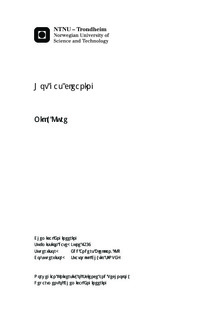| dc.description.abstract | Five H2S adsorbent materials for hot gas cleaning of biomass-derived synthesis gas were prepared. Three of the new sorbents were prepared based on a novel manganese-based sorbent that uses alumina support. The new adsorbent materials were prepared with 15 wt% manganese loading on different supports as ZrO2, TiO2 and CeO2. The supports have different physico-chemical properties. Two alumina based sorbents were prepared with 15 and 30wt% manganese loading on the alumina support. All the sorbents were prepared by single impregnation method except for the 30wt% loading which was prepared by double impregnation. This study required to investigate the sorption activities of the new developed materials and compare their performance with the novel alumina based sorbents.
The new sorbents were characterized along-side the alumina based sorbents using nitrogen adsorption, X-ray diffraction, Thermogravimetric Analysis, Temperature Programmed Reduction and oxygen pulse chemisorption methods. Raman spectroscopy analysis was also carried out however due to inability to replicate results for a reference manganese oxide sorbent the results have not been included in the main report but have been attached to the appendix for the interested reader.
A new laboratory based set-up unit was to be used to test sorption activities. Various challenges were faced while ensuring that the new laboratory set up was running safely and efficiently, and as a result, the remaining time was not enough to test all the five sorbents that were prepared. The sorption tests were only performed on the alumina based sorbents, in duplicate. The second set of experiments was performed with doubled amounts of sorbents, sorption gases and regeneration gases. This in a way, served to confirm reproducibility of results with the new laboratory setup. The new developed sorbent materials have been handed over to the supervisors and left as future work.
The sorption studies of the alumina based sorbents were performed by carrying out repeated sulfidation and regeneration reaction cycles 4500C. The results were monitored and measured by a mass spectrometer. A total of thirteen sorption cycles were performed in each experiment by using a sorption gas mixture of N2, H2 and H2S (Ar) with H2S concentration of 0.4% in the feed for the sulfidation reaction and O2 diluted in N2 (10% O2) gas for the regeneration reactions. The first and last sorption cycles were measured as full sorption cycles meaning they were allowed to go to maximum saturation of the sorbent with H2S. Cycles 2 to 12 were performed as short sorption cycles and were not allowed to reach maximum saturation. The sulfidation reaction was stopped when the H2S concentration in the outlet gas reached 0.1%. This allowed as many as 5 sorption cycles to be carried out in one day. The steps involved in each sorption cycle can be summarized as flushing, sulfidation, flushing and regeneration. One short sorption cycle took approximately one and a half hours.
Sorption capacities for the alumina based sorbents have been calculated as gH2S/gSorbent from the measurement data obtained through sorption studies. A breakthrough point of 0.02% H2S concentration was used. | |

